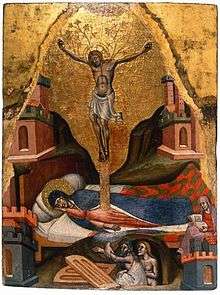Simone dei Crocifissi

Simone di Filippo Benvenuti, known as Simone dei Crocifissi or Simone da Bologna, (Bologna, about 1330 - Bologna, 1399), was an Italian painter. He painted many religious panel paintings, and also frescoes in the churches of Santo Stefano, Bologna and San Michele in Bosco, Bologna.
Life
Simone dei Crocifissi was born in Bologna. He was son of the shoemaker Filippo di Benvenuto. In the seventeenth century he was renamed "of the Crucifixes" (dei Crocifissi) for his "ability to paint great images of the Redeemer, for our sake nailed to the cross" (Malvasia). He trained with Franco Bolognese.
He was active as a painter of Bologna during 1354 to 1399 in the wake of Vitale da Bologna's previous experience, which he engaged in a robustly more popular style of painting.
The initial artistic phase of Simone Di Fillipo can be seen via the frescoes of the life of Christ that come from the church of Santa Maria di Mezzaratta (mid-fifties of the fourteenth century), now preserved in the National Art Gallery of Bologna (Pinacoteca di Bologna), where the interest for Florentine Giotto's space and plastic solutions is interpreted with a sharp expressivity.
The influence on Simone of Vitale's painting style can be caught in works such as the polyptych 474, also preserved at the Pinacoteca. On the other hand, works like the Pietà by Giovanni Elthinl (1368), and the Crucifix of St. James (1370), on display in the same museum, highlight the influence of Jacopo Avanzi and his solemn style, even if re-interpreted stressing the devotional goal, as in the Madonna by Giovanni da Piacenza (1382). These are the characteristics that enabled Simone dei Crocifisso to reach a leading position in Bologna soon afterwards, gaining pre-eminence as the author of wooden altarpieces for local churches and for individual customers.

Frescoes
National Art Gallery of Bologna:
In a document of 1366 undertook to paint five episodes of the Old Testament in the church of S. Apollonia Mezzaratta (near Bologna), but the scenes he attributed stylistically belong to the New Testament cycle:
- Circoncisione, firmata JACOBUS ET SYMON;
- Fuga in Egitto;
- Guarigione del paralitico firmata SYMON;
- Resurrezione di Lazzaro;
Paintings on wood
Bologna, National Art Gallery of Bologna:
- Coronation of the Virgin (firmata SYMON FECIT), originally from the Basilica di San Domenico, Bologna;
- Coronation of the Virgin and Saints , inv. 254, polyptych signed SYMON DE BONONIA FECIT HOC OPUS;
- Coronation of the Virgin and Saints , inv. 298, polyptych from church of San Leonardo, signed SYMON FECIT HOC OPUS;
- Crucifixion, inv. 286, cusp of polyptych;
- San Bernardo Tolomei consegna la regola, inv. 1078;
- St Helen in prays to Cross and Dominican nun inv. 220, tempera on Canvas;
- Madonna and child, angels and donor Giovanni da Piacenza (1378), inv. 225, from the church of Madonna del Monte;
- Pope Urban V, inv. 303, signed SYMON FECIT;
- Sette episodi della Vita della Madonna, predella del Cospi polyptych Basilica di San Petronio;
- Pietà and donor Giovanni Elthinl (1368); Museo Davia Bargellini, Bologna
- Crucifix, Museum of San Giuseppe Sposo, Bologna
- Crucifix, (1370), church of San Giacomo Maggiore, Bologna
- Crucifix, church of Santo Stefano, Bologna
- Bologna, Museum of Santo Stefano, Madonna col Bambino e i Santi Paolo, Giovanni Battista, Pietro, Giacomo Maggiore, Andrea, Bartolomeo, Benedetto, Sisto papa, Procolo, tavole di un polittico smembrato dalla chiesa di San Procolo;
- Bologna, Museum of Santo Stefano, Santo vescovo, fragment of Polyptych smembrato;
- Bologna, Museum of San Petronio, San Pietro e devoti e San Petronio, due tavole di polittico smembrato;
- Bologna, church of San Salvatore, Madonna con Bambino in trono, detta Madonna della Vittoria, dalla chiesa della Madonna del Monte;
- Budrio, Pinacoteca Civica "Domenico Inzaghi", inv. 306 (deposito della Pinacoteca Nazionale di Bologna), Incoronazione della Vergine;
- Modena, Galleria Estense, inv. 254, Madonna con Bambino in trono e angeli;
- Dream of the Virgin (cusp of polyptych), inv. 57, Pinacoteca Nazionale, Ferrara
- Coronation of the Virgin and Angels, inv. 361, Pinacoteca Nazionale, Ferrara
- Nativity, inv. 3475, Galleria degli Uffizi, Florence
- Rome, Galleria Nazionale d'Arte Antica di Palazzo Barberini, Madonna con Bambino in trono e santi, trittico;
- Tossignano, chiesa di San Michele, Madonna col Bambino e angeli, detta Madonna della Spiga;
- Madonna con Bambino, San Giovanni Battista e Santa Maria Maddalen a altarolo portatile, Louvre, Paris
- Coronation of the Virgin and Angels, Sotheby's 1989, now in private collection
Further reading
- E. Sandberg Vavalà, Vitale delle Madonne e Simone dei Crocifissi, in Rivista d'arte, XI 1929, pp. 449–480
- Eugenio Riccomini, La pittura bolognese del Trecento, (I maestri del colore 245), Fabbri, Milano 1966
- Massimo Ferretti, Rappresentazione dei Magi. Il gruppo ligneo di S.Stefano e Simone dei Crocefissi, Bologna 1981
- Alessandro Volpe, Mezzaratta. Vitale e altri pittori per una confraternita bolognese, BUP, Bologna 2005
- Pinacoteca Nazionale di Bologna. Catalogo generale. 1. Dal Duecento a Francesco Francia, Bologna 2004, pp. 98–152
External links
-
 Media related to Simone dei Crocifissi at Wikimedia Commons
Media related to Simone dei Crocifissi at Wikimedia Commons - Museo civico Medievale
- National Art Gallery of Bologna
